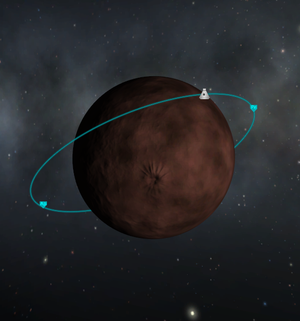Orbit

An orbit is an elliptical path around a celestial body. The point on an orbit which is closest to the orbited body is called the periapsis; the furthest point is the apoapsis. (These points are indicated on the map view as "Pe" and "Ap", respectively.)
An orbit is considered "stable" if all points in the orbit are above the terrain and atmosphere of the orbited body. A spacecraft in such an orbit will not lose velocity due to atmospheric drag or collisions with terrain.
To achieve orbit, a spacecraft must reach a sufficient altitude and orbital velocity. During ascent, a gravity turn helps to achieve both of these goals in a fuel-efficient way. To establish or change your orbit, try some of these Basic Maneuvers.
Orbits in the Save File
The save files (and scenarios) in KSP are plain text and human readable. Inside you will find information on the orbit of every craft currently in the game. It looks something like this:
ORBIT {
- SMA = 76875.4600066045
- ECC = 0.136808532664149
- INC = 32.6082297441138
- LPE = 91.4665699628126
- LAN = 305.802690796769
- MNA = 0.556028537338098
- EPH = 19189976.1161395
- REF = 3
- OBJ = 0
}
Each of these terms has a meaning, and changing them (and then re-loading your save game) will change the orbit of the vessel in question. (definitions shamelessly lifted from Wikipedia)
- SMA : Semimajor axis - the sum of the periapsis and apoapsis distances divided by two.
- ECC : Eccentricity () - shape of the ellipse, describing how much it elongated compared to a circle.
- INC : Inclination - vertical tilt of the ellipse with respect to the reference plane, measured at the ascending node.
- LPE : Longitude of periapsis - horizontally orients the periapsis of the ellipse.
- LAN : Longitude of the ascending node - horizontally orients the ascending node of the ellipse.
- MNA : Mean anomaly at epoch - defines the position of the orbiting body along the ellipse at a specific time.
- EPH : epoch - the reference time for the orbit.
- REF : reference body - the ID of the body around which the orbit occurs. 0 is the sun, 1 is Kerbin, 2 is Mun, 3 is Minmus. Presumably this sequence continues, but I don't know what the other ID numbers are.
- OBJ : Some sort of object reference (I wouldn't change this number). It appears that 0 corresponds to probes, and 1 corresponds to debris.
By altering these values in the save file, one can easily "slew" vehicles into any position desired. This is very useful for setting up scenarios.